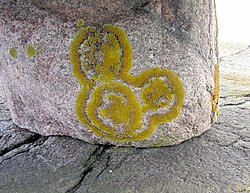
Back Cenfetreg Welsh Lichenometrie German Liquenometría Spanish Lichénométrie French Lichenometria Italian Lichenometrie Dutch Lichenometri NB Lichenometria Polish Lichenometry SIMPLE Lichenometri Swedish



In archaeology, palaeontology, and geomorphology, lichenometry is a geomorphic method of geochronologic dating that uses lichen growth to determine the age of exposed rock, based on a presumed specific rate of increase in radial size over time.[1][2]: 9 Measuring the diameter of the largest lichen of a species on a rock surface can therefore be used to determine the length of time the rock has been exposed. Lichen can be preserved on old rock faces for up to 10,000 years,[3] providing the maximum age limit of the technique, but it is most accurate (within 10% error) when applied to surfaces that have been exposed for less than 1,000 years.[4] (The practical limit of the technique might be 4,000 to 5,000 years.[3])
Lichenometry is especially useful for dating surfaces less than 500 years old, as radiocarbon dating techniques are less accurate over this period.[5] The lichens most commonly used for lichenometry are those of the genera Rhizocarpon (such as the species Rhizocarpon geographicum) and Xanthoria. The measured growth rates of R. geographicum tends to fall within the range of 0.9–0.3 millimeter per year, depending on several factors, including the size of the lichen patch.[6]
The technique was first employed by Knut Fægri in 1933, though the first exclusively lichenometric paper was not published until 1950, by Austrian Roland Beschel,[7] in a paper concerning the European Alps.[8]
- ^ Holocene climatic and glacial history of the central Sierra Nevada, California, R.R. Curry, pp. 1–47, 1969, Geological Society of America Special Paper, 123, S.A. Schumm and W.C. Bradley, eds., 1969
- ^ Lichens in relation to management issues in the Sierra Nevada national parks, McCune, B., J. Grenon, and E. Martin, L. Mutch, Sierra Nevada Network, Cooperative agreement CA9088A0008. Oregon State University, Corvallis, Oregon, and Sequoia and Kings Canyon National Parks, Three Rivers, California, [1]
- ^ a b Benedict, James B. (January 2009). "A Review of Lichenometric Dating and Its Applications to Archaeology". American Antiquity. 74 (1): 143–172. doi:10.1017/S0002731600047545. S2CID 83108496.
- ^ Sowers, J.M., Noller, J.S., and Lettis, W.R., eds., 1997, Dating and Earthquakes: Review of Quaternary Geochronology and its Application to Paleoseismology. U.S. Nuclear Regulatory Commission, NUREG/CR 5562.
- ^ Innes, John L. "Lichenometry". Progress in Physical Geography. 9 (187).
- ^ Armstrong, R. A. (August 1983). "Growth Curve of the Lichen Rhizocarpon Geographicum". New Phytologist. 94 (4): 619–622. doi:10.1111/j.1469-8137.1983.tb04870.x. ISSN 0028-646X.
- ^ Beschel, R. (1950). "Flechten als Altersmasstab rezenter Moränen". Zeitschrift für Gletscherkunde und Glazialgeologie. 1: 152–161.
- ^ "Lichenometry". Archived from the original on 2008-08-23. Retrieved 2009-02-25.
© MMXXIII Rich X Search. We shall prevail. All rights reserved. Rich X Search